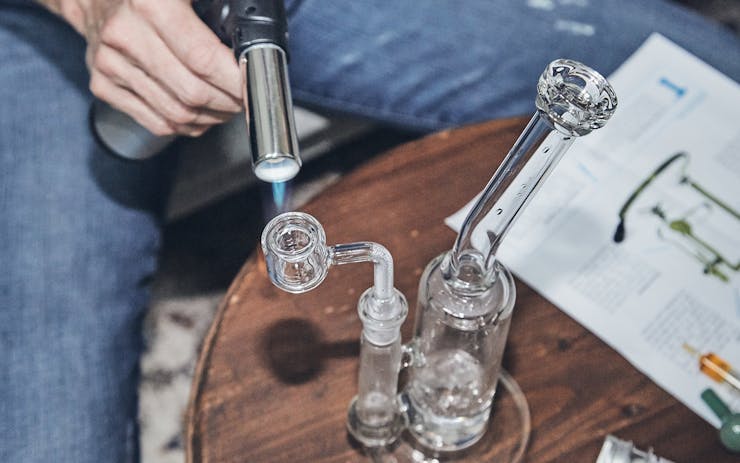Dabbing is a method of consuming cannabis that involves flash vaporizing an extract—called a “dab”—on a hot surface and inhaling the vapor through a pipe. Popular for its fast-acting and hard-hitting high, dabbing is often too intense for cannabis beginners (although it is possible to dab with non-intoxicating CBD extracts). In order to dab, you must have a dab rig, which is usually a glass pipe with specific attachments that allow you to apply extracts.
“I took my first dab yesterday and ended up eating two servings of pad thai.”
“Take a dab of this Tangie rosin.”
What is dabbing?
Dabbing is the process of flash vaporizing cannabis extracts—called “dabs”—off a hot surface and inhaling for fast-acting, potent effects. In order to dab, you need to have a special attachment for your glass pipe, typically a “nail.” The nail is heated up, usually with a handheld butane torch—such as culinary torches—and cannabis oil is applied to the nail after it cools. As the oil goes up in a cloud of vapor, you inhale just as you would when hitting a pipe or bong. You can also cover the nail with a carb cap to control the hit better.
Dabs, as a noun, refer to cannabis oils and extracts that can be used in a dab rig. There are many different types of dabbable extracts including BHO, rosin, wax, and shatter. They may differ in color, consistency, potency, and texture, and are made using a variety of different extraction techniques.
Because its effects can be powerful, dabbing is a method of cannabis consumption best suited for seasoned smokers who prefer larger, more potent doses of cannabis.
What are the benefits to dabbing?
Dabbing has become a popular means of achieving quick, potent effects from cannabis oils. For this reason, dabbing is sometimes the recommended consumption method for individuals in need of swift relief of symptoms.
Because oils used for dabbing are refined in an extraction process, they eliminate the need to smoke harsh plant material. However, it’s important to consume lab-tested extracts that have been cleared of any contaminants or residual solvents.
How to dab
As dabbing has increased in popularity, the available technology with which to dab has also expanded. However, traditional methods of dabbing involve the following tools:
- Dab rig (small glass water pipe)
- Nail, which rests in the same socket that would otherwise hold a bowl piece
- Blow torch (most use a small culinary butane torch)
- Dabber—an applicator tool, usually a metal or glass stick with a pointed end to handle extracts
- Cannabis extract
The nail is heated using the torch, typically for about 30 seconds, depending on the material of the nail. It is left to cool—again, the amount of time depends on the nail’s material—so vapor does not burn your throat. Once it has reached the optimal temperature, use a dabber to scoop a small amount of cannabis concentrate from its container. Apply your dab and inhale. If using a carb cap, place it over the nail before inhaling.
Where to get dabs
Cannabis extracts suitable for dabbing, such as rosin or BHO, can be found at most cannabis shops and dispensaries.
It is very dangerous to make your own BHO (butane hash oil) at home, as butane vapors can become trapped and ignite, resulting in an explosion. A safer way to make DIY dabs is by using a rosin press, which utilizes only heat and pressure to extract essential oils from cannabis buds.
